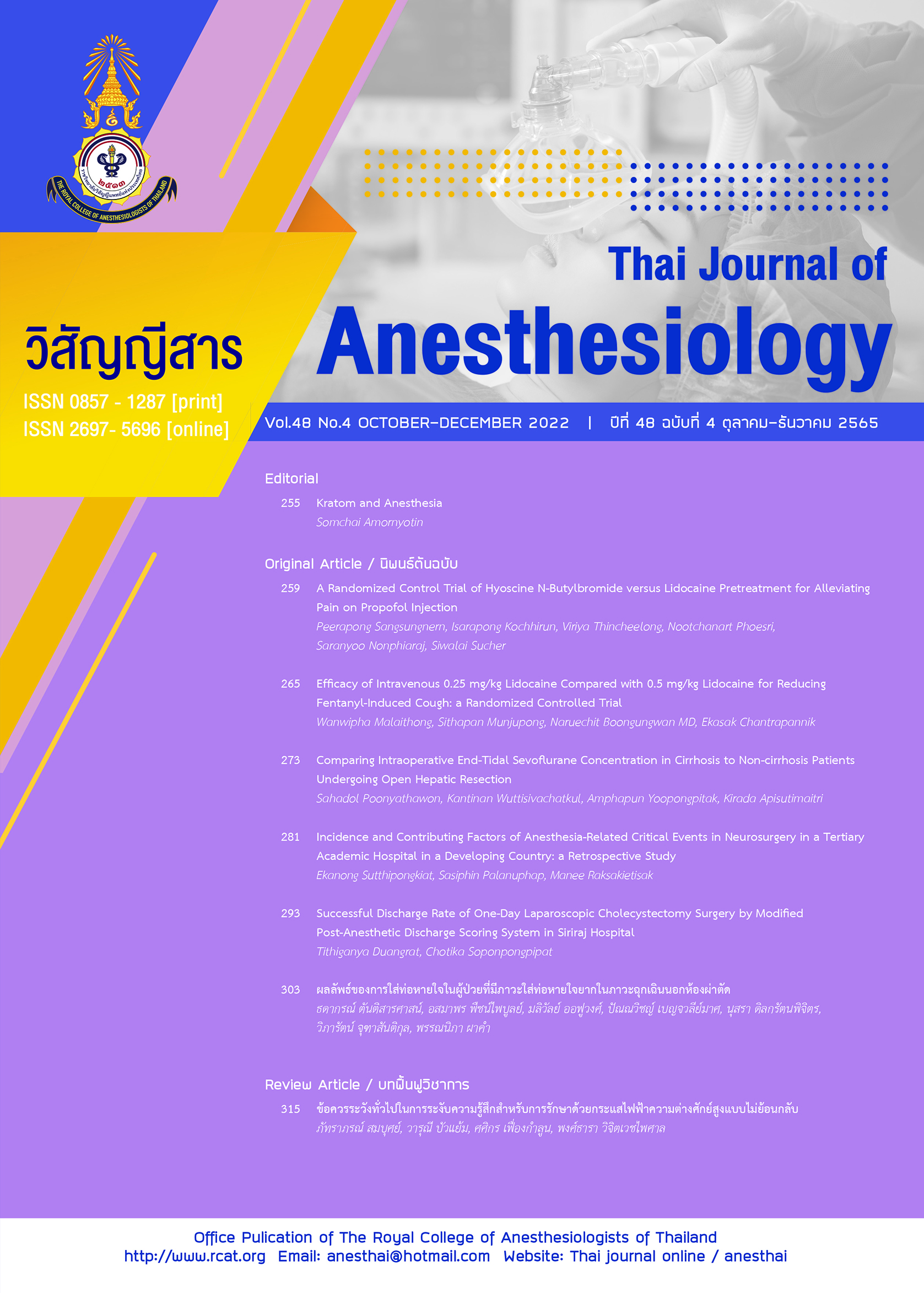Comparing Intraoperative End-Tidal Sevoflurane Concentration in Cirrhosis to Non-cirrhosis Patients Undergoing Open Hepatic Resection
Main Article Content
Abstract
Background: The effect of hepatic cirrhosis on anesthetic requirement is still uncertain. Some studies showed that, end stage hepatic disease or cirrhotic patients might have less inhalational anesthetic requirement than patients with normal hepatic function. In this study, during major hepatic resection, end-tidal sevoflurane concentration was compared between cirrhosis and non-cirrhosis patients. Methods: Our prospective observational study included 30 patients with hepatic tumors undergoing open major hepatic resection. The patients were divided into two groups: cirrhosis group (n=15) and non-cirrhosis group (n=15). Thoracic epidural combined with general anesthesia was performed. End tidal sevoflurane concentration was adjusted with target BIS between 40-55. Morphine and lidocaine were given via epidural catheter for pain control during perioperative periods. The primary outcome of the study is mean end-tidal sevoflurane. Demographic data including age, sex, weight, ASA physical status and other secondary outcomes were obtained from anesthetic records. Results: The mean end-tidal sevoflurane concentration was 1.59±0.23 vol.% in cirrhosis group and 1.67±0.19 vol.% in non-cirrhosis group (P=0.329). Minimal alveolar concentration (MAC) in cirrhosis group and non-cirrhosis group were 0.84±0.10 and 0.87±0.07 (P=0.330), respectively. There is no significant difference in demographic data except for the ASA status (P=0.002) and the duration of operation (P=0.033). Conclusion: Our study shows that there is no difference in end-tidal sevoflurane concentration, minimal alveolar concentration between cirrhosis and non-cirrhosis.
Article Details

This work is licensed under a Creative Commons Attribution-NonCommercial-NoDerivatives 4.0 International License.
References
Kulik L, El-Serag HB. Epidemiology and management of hepatocellular carcinoma. Gastroenterology. 2019;156:477-91.e1.
Omata M, Cheng AL, Kokudo N, et al. Asia-pacific clinical practice guidelines on the management of hepatocellular carcinoma: a 2017 update. Hepatol Int. 2017;11:317-70.
Mansour A, Watson W, Shayani V, Pickleman J. Abdominal operations in patients with cirrhosis: still a major surgical challenge. Surgery. 1997;122:730-5.
Baron-Stefaniak J, Gotz V, Allhutter A, et al. Patients undergoing orthotopic liver transplantation require lower concentrations of the volatile anesthetic sevoflurane. Anesth Analg. 2017;125:783-9.
Ko JCH, Abbo LA, Weil AB, Johnson BM, Inoue T, Payton ME. Effect of orally administered tramadol
alone or with an intravenously administered opioid on minimum alveolar concentration of sevoflurane in cats. J Am Vet Med Assoc. 2008;232:1834-40.
Donovan KL, Janicki PK, Striepe VI, Stoica C, Franks WT, Pinson CW. Decreased patient analgesic requirements after liver transplantation and associated neuropeptide levels. Transplantation. 1997;63:1423-9.
Farrell GC, Cooksley WG, Powell LW. Drug metabolism in liver disease: activity of hepatic microsomal metabolizing enzymes. Clin Pharmacol Ther. 1979;26:483-92.
Quero JC, Schalm SW. Subclinical hepatic encephalopathy. Semin Liver Dis. 1996;16:321-8.
Yin Y, Xiao H, Han J, Zhang W, Cheng J, Zhu T. Effect of the severity of liver dysfunction on the minimum alveolar concentration of sevoflurane responding to an electronic stimulation in cirrhotic patients. BMC Anesthesiol. 2016;16:98.
Petsiti A, Tassoudis V, Vretzakis G, et al. Depth of anesthesia as a risk factor for perioperative morbidity. Anesthesiol Res Pract. 2015;2015:829151.
Melloul E, Hubner M, Scott M, et al. Guidelines for perioperative care for liver surgery: Enhanced Recovery After Surgery (ERAS) Society recommendations. World J Surg. 2016;40:2425-40.
Chow FC, Chok KS. Colorectal liver metastases: an update on multidisciplinary approach. World J Hepatol. 2019;11:150-72.
Yin Y, Yan M, Zhu T. Minimum alveolar concentration of sevoflurane in rabbits with liver fibrosis. Anesth Analg. 2012;114:561-5.
Farrell GC, Zaluzny L. Microsomal protein synthesis and induction of cytochrome P-450 in cirrhotic rat liver. Aust J Exp Biol Med Sci. 1984;62:291-301.
Refaat E, Yassein T. Reduced sevoflurane consumption in cirrhotic compared to non-cirrhotic patients undergoing major hepatic surgery: during entropy monitored general anesthesia. Egypt J Anaesth. 2013;29:61-5.
Wang CH, Chen CL, Cheng KW, et al. Bispectral index monitoring in healthy, cirrhotic, and end-stage liver disease patients undergoing hepatic operation. Transplant Proc. 2008;40:2489-91.
Fragen RJ, Dunn KL. The minimum alveolar concentration (MAC) of sevoflurane with and without nitrous oxide in elderly versus young adults. J Clin Anesth. 1996;8:352-6.
Eger EI 2nd. Age, minimum alveolar anesthetic concentration, and minimum alveolar anesthetic concentration-awake. Anesth Analg. 2001;93:947-53.
Llovet JM, Bru C, Bruix J. Prognosis of hepatocellular carcinoma: the BCLC staging classification. Semin Liver Dis. 1999;19:329-38.
Eguchi S, Kanematsu T, Arii S, et al. Recurrence-free survival more than 10 years after liver resection for hepatocellular carcinoma. Brit J Surg. 2011;98:552-7.
Goodman ZD. Grading and staging systems for inflammation and fibrosis in chronic liver diseases. J Hepatol. 2007;47:598-607.
Bromage PR, Camporesi EM, Durant PA, Nielsen CH. Rostral spread of epidural morphine. Anesthesiology. 1982;56:431-6.
Chaney MA. Side effects of intrathecal and epidural opioids. Can J Anaesth. 1995;42:891-903.
Rudin A, Lundberg JF, Hammarlund-Udenaes M, Flisberg P, Werner MU. Morphine metabolism after major liver surgery. Anesth Analg. 2007;104:1409-14.


